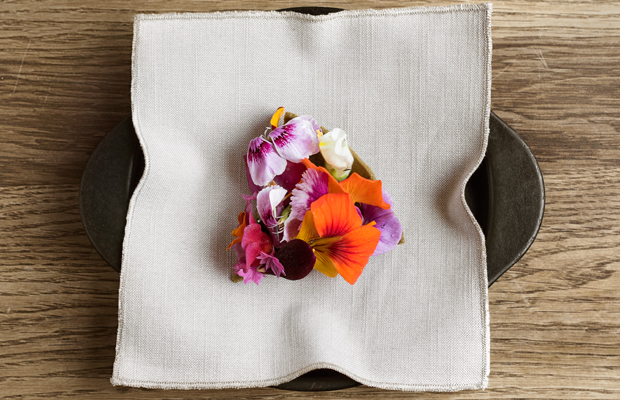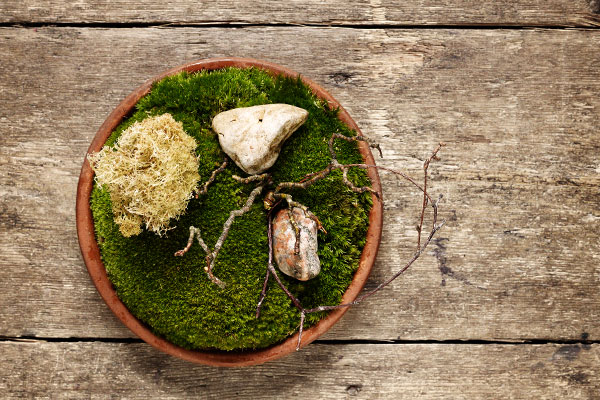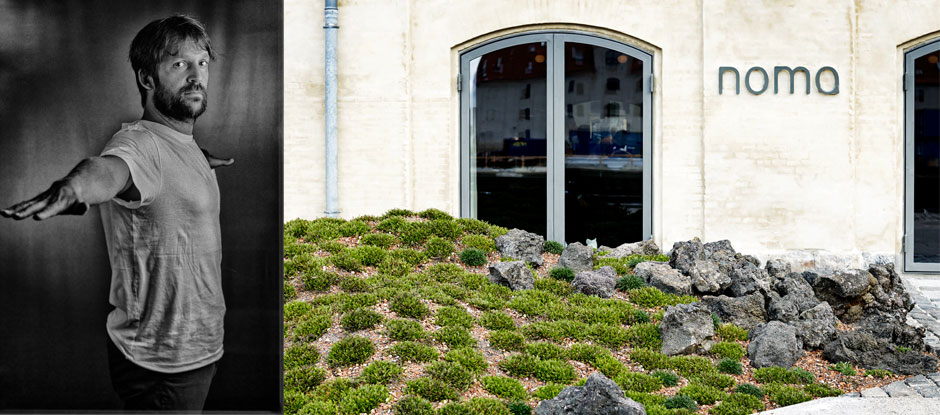Header: René Redzepi (portrait: © Gianni Villa) and the Noma exterior
As he prepares to open Noma 2.0, we find out what drives the chef behind the restaurant voted No.1 in the world four times. In the fifth instalment of our Best and Beyond series, presented by Miele, we meet René Redzepi.
René Redzepi has been called a lot of things in his life: the world’s best chef; a visionary; a culinary genius. But he’s also been labelled with less favourable monikers. In 2003, when the idea for Noma, a restaurant in Copenhagen that would use only Nordic ingredients, was announced it was derided by some of Redzepi’s closest friends, who dubbed it the ‘blubber restaurant’ and called him and his team ‘seal fu***rs’. The idea that anyone would open a top-end restaurant in Denmark based not on the classic cuisines of France or Italy but on Nordic food was absurd. Everyone thought it was impossible.
Everyone except Redzepi and business partner Claus Meyer, that is. Earlier that year the entrepreneurial Meyer had called Redzepi, a 25 year-old sous chef, and asked if he would be chef patron at his new restaurant in a waterfront warehouse in the Christianshavn neighbourhood of central Copenhagen. The dream was to create somewhere that would challenge the Old World order of gastronomy and celebrate a hitherto ignored – and undefined – cuisine. It would be called Noma – a truncation of the Danish words Nordisk (Nordic) and mad (food).
Today, almost a decade and a half on, it’s hard to think of global cuisines without considering that of Scandinavia. Nordic cooking and its simple, minimalist approach to ingredients has become part of the culinary psyche, influencing and guiding chefs all over the world in the same way that the classic techniques of la gastronomie française still inform much of today’s fine dining. But back in 2003 it simply didn’t exist.
Watch the video interview with René Redzepi:
New Nordic Cuisine
It is this point alone that makes Redzepi and Noma such important protagonists in the history of modern gastronomy. Few chefs can claim to have created a new style of cuisine – not that Redzepi would ever make so bold a claim – but that will be his legacy. In 2004, on the initiative of Redzepi and Meyer, chefs from all of the Nordic countries met in Copenhagen to discuss the creation of a ‘New Nordic Cuisine’ based on simplicity, freshness and seasonality, with restaurants encouraged to develop dishes using ingredients local to them. The Nordic Kitchen Manifesto was drawn up that outlined 10 aims of the new movement.
“What is it that sets us apart from so many other places?” says Redzepi. “More and more we’re becoming the same all throughout the world. Some places, they have a little more vegetables than others, but it’s kind of the same all the time.
“So at one point it just dawned on us that we really only have three strict ingredient seasons in our Nordic region. We have a very cold season, which in Denmark, at least, spans from January until April, when nothing grows. That’s when the ocean is in season. Why haven’t we just been focusing on the ocean instead of trying to put in all these things that are necessary in the standard tasting menu?
“Then comes a green season when ingredients are abundant, you can pick and choose hundreds of things. So why haven’t we just focused on that? Why were we always pushed into having that meat main course because that’s what the tasting menu dictates? So we’ll be vegetarian in that season. And then when the forest season starts, game comes into season [along with] berries and mushrooms, that’s when you should eat meat.”
At Noma, Redzepi wanted to show diners where they were in the world and what time of year it was through what they were eating. It was a basic tenet in principle, but something that was very difficult to do in practice given the geographical constraints. Nevertheless, it is a trick that he has pulled off to high acclaim.
Not everything served at Noma is native to the Nordic countries – you’ll find the odd splash of olive oil in dishes – but through foraging, meticulous sourcing and an almost instinctive understanding of the natural world around him, Redzepi’s dishes resonate with their immediate environment. This was, as it was later coined, borrowing terminology from the wine industry, ‘terroir cooking’.
Flower pie at Noma
Becoming the best
Back in 2004, when Redzepi admits he finally fully released himself from the ideologies of other high-end restaurants he had worked in – most notably El Bulli in Spain and The French Laundry in the US – a meal at Noma was like nothing else in the world. It wasn’t long before word got out that a maverick chef was doing the seemingly impossible of not only creating entire meals out of Nordic ingredients but making them taste better than more luxurious imports. Could a dish of cod liver and milk crisp really taste better than foie gras or caviar? The answer was a resounding yes.
In 2006 Noma entered The Worlds 50 Best Restaurants list at No.33: four years later it would sit at the top of the world. When, in 2010, it was named The World’s Best Restaurant for the first time (it would claim the title another three times, in 2011, 2012 and 2014), Redzepi referenced the early name calling of him and his restaurant in his acceptance speech. “It didn’t bother us,” he said. “It fuelled us.”
Redzepi has always been fully aware that when you try something new you risk being shot at. And when people don’t understand you, you appear more frequently in their cross-hairs.
The progeny of a Macedonia farming family who moved to Denmark before he was born, Redzepi’s half-Danish, half-Macedonian background has made him an object of racism (he speaks openly on this subject in the biopic Noma: My Perfect Storm). Equally, some people found it inconceivable that the champion of a pure Nordic style of cooking was not himself a ‘pure’ Scandinavian.
This has all been grist to Redzepi’s mill and has given him a groundedness and a focus that has permeated everything he does. It has also given him a fearlessness to challenge many dining norms, in particular the notion of fine dining itself.
When you eat at Noma you do not do so off tables of white linen. The decor is stripped back and modest and holds a mirror up to the food that you are eating. Waiting staff do not look like extras from a Bond film and instead Redzepi encouraged an unpretentious way of serving food. ‘F**k the bow tie’ is one of his mottos. Expensive cutlery also has no place in his dining room. “I ate chicken with my hands in Macedonia. Would it have tasted better if I’d eaten it with silver cutlery? No.”
But more than that, at Noma Redzepi challenged the idea of service and the traditional dining room hierarchy that meant chefs remained one side of the pass, waiting staff the other.
Instead, he pioneered the practice of having chefs cross the dining room rubicon and serve the guests themselves. From the very early days of Noma, the person who creates the dish presents it. Redzepi believed that if a chef looked a diner in the eye, it would help them to understand the true point of their dish.
Finnish moss with pulverised ceps (image: Mikkel Heriba)
Noma the nomad
Claiming the title of The World’s Best Restaurant is something that Redzepi and his team cherish, and it changed the fate of the restaurant overnight. But accolades were not the reason behind setting up Noma and they have never been the driving force for the restaurant Instead, Redzepi is impelled by a constant urge to re-evaluate things, to keep asking questions, to keep moving forward.
He cites the rebirth of Noma after the norovirus incident when, in 2011, 63 people became ill after eating at the restaurant, as being a seminal moment. As an event, it brought into focus what it meant to run a restaurant and to feed people, and led him to step back and reassess what he was trying to do at Noma.
That’s not to say that up until this point Noma had become less creative, or had sat on its world-beating laurels. The Noma kitchen has always been not just a place for cooking but for exploring new ideas and, equally important, nurturing talent.
Since 2005, every Saturday night after service – at around 2am – the chefs would gather to present their own creations to Redzepi and his senior team. It was an opportunity that everybody in the kitchen prized and it gave them a chance to show to their master what they had learnt under his tutelage.
The dishes they produced rarely got on the menu, but that’s not the point. For Redzepi, the purpose of the exercise was to help his chefs form independent attitudes to food and scrutinise what they were cooking. It gave them a chance to experiment without fear of failure. “You can fail as much as you want, as long as you do it 100%,” he says of the red-eye sessions. “From there the discussion starts.”
This continual introspection and progression would lead to wanderlust, and for Redzepi to explore ideas beyond the geographical boundaries of his homeland. Noma became the nomad, travelling the world and immersing itself fully in another country’s culinary heritage for a number of weeks or months before moving on.
In 2012, Redzepi took his first tentative steps in this direction with a short residency at Claridge’s in London, timed to coincide with the refurbishment of the restaurant back home. As part of the menu, the kitchen transported thousands of live ants, which he served crawling over a salad starter.
This pop-up laid the framework for more ambitious projects. In 2015 , Noma opened in Tokyo for two months, the live ants this time gracing a hokkaido shrimp, and a year later he took Noma to Sydney for 10 weeks.
Earlier this year he set up his restaurant in Tulum in Mexico. Amid criticism that his $600 per person dinner was at odds in a country where the average daily wage is $15, he created a scholarship for Mexican culinary students to travel to Copenhagen and allowed culinary students to eat for free.
Closing chapter
This nomadic approach met its inevitable apotheosis with the original Noma shutting in February 2017. On his travels Redzepi had experienced new horizons and he could no longer see his waterside restaurant being the crucible of creativity it once was.
“I decided to close Noma for many reasons,” he says. “I mean, it’s 14 years old, I’m 40 years old. I was thinking ‘Okay, either we stay here for the next 20 years or... why don’t we just try something else, move somewhere else, and break the routine?’
“One of the most dangerous things for creativity is routine. Being so confident and knowing exactly what to do does kill your creativity. So in an effort to keep pushing and keep moving we decided, let’s just close. The point is that we dare again to fail, whereas with the old Noma, it had to be perfect."
This isn’t the end though, just the start of yet another new chapter for Redzepi. Noma 2.0, as he calls it, is on track to open in December and will comprise an experimental farm as well as a restaurant.
Here Redzepi and his team will experiment with numerous varieties of individual plants and share the findings. The farming element is more about biodiversity and rekindling bygone agricultural practices than simply growing fruit and veg.
But then this is the case with everything Redzepi does. Not content with merely scratching the surface, he immerses himself in each project he undertakes. From his fermentation kitchen at Noma and the Nordic Food Lab, a not-for-profit experimental kitchen he set up on a houseboat in 2008 to the annual MAD symposium he launched in 2011 that ‘brings together a global cooking community with a social conscience and a sense of curiosity’, Redzepi is much more than just a chef.
As well as being a global culinary leader, he is an adventurer, activist and agent of change, who always looks beyond the obvious. Even the early naysayers can’t argue with that.
Now watch the launch of Redzepi's Wild Food initiative at #50BestTalks:
Watch the videos and read the interviews with all seven of the chef-owners of the past and present No.1s in The World's 50 Best Restaurants as part of our Best and Beyond series, presented by Miele: Massimo Bottura, Ferran Adrià, Joan Roca and Heston Blumenthal. Look out for Thomas Keller and Daniel Humm, coming soon.
Stay tuned to our Facebook, Instagram and Twitter channels for alerts and subscribe to our YouTube channel for more videos.

